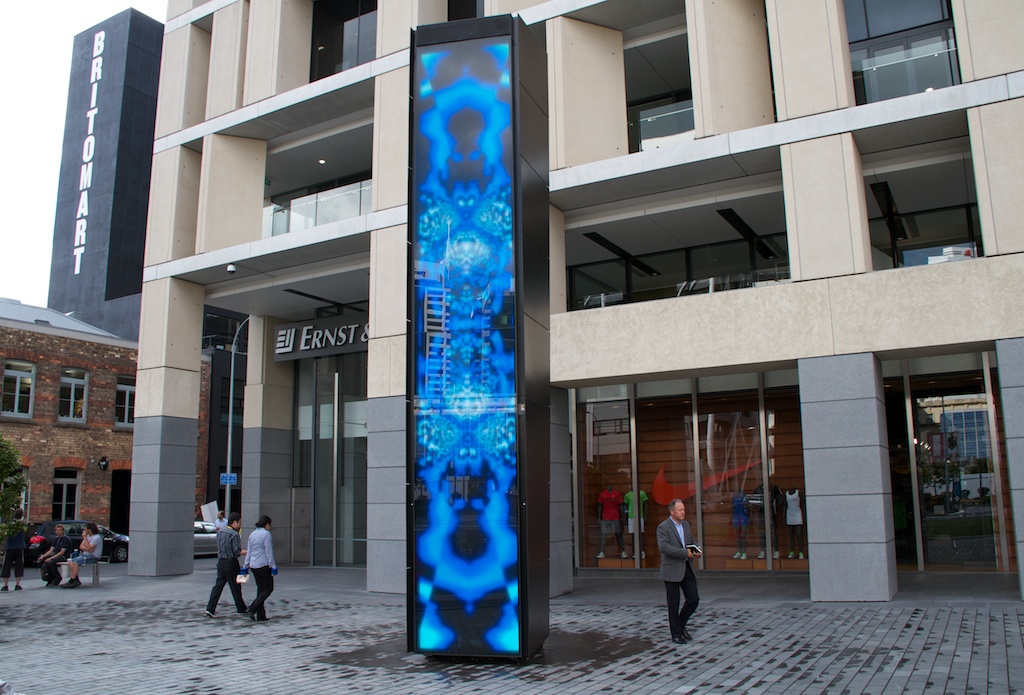

SCOUT
Auckland,
Takutai Square, Britomart Precinct
Permanent
Installation
Commissioners
: Cooper and Company through Britomart Arts Trust
Artist
: Tim Gruchy - concept, programming & visuals
Sound
: Tim Gruchy & James Pinker
Project
Manager : Matt Smith
Architectural
Consultants; Richard Johnson & Mat Howard - JPW architects
Engineer
: Wilson Liyu
Back
More
Images
|
SCOUT
- Tim Gruchy
SCOUT
2012
LED video display, LED strip light, touch screen, speakers, microphone,
video camera, environmental sensors, networked computers, audio and
media servers, generative computer programme in glass, compressed fibreboard
and steel shell
ARTIST STATEMENT:
SCOUT (Sentient Co-relator Of Urban Transaction) has come to Takutai
Square.
The essence of the idea for SCOUT comes from the short story by Arthur
C Clarke The Sentinel, which he wrote in 1948 and later developed into
2001 A Space Odyssey. I'm very interested in intelligence, not just
human intelligence but how intelligence evolves and may be distributed
through the universe. SCOUT seeks to hone our awareness towards a broader
understanding of sentience and intelligence beyond just the human condition
Behaviour is regarded as a strong indicator of intelligence. Social
behaviour or the hive mind is an area of growing scientific interest.
We often imbue technology with the quality of intelligence, while the
pursuit of artificial intelligence has long been a driver in the evolution
of computing. The growing complexity of computers and software leads
inevitably to the notion of the singularity, a point somewhere in the
future when computer intelligence surpasses the capacity of the human
mind. SCOUT both monitors behaviour and exhibits a behaviour of its
own.
I posit SCOUT as a benevolent, non-human intelligent entity that engages
with its environment and the people within it, transacting in the urban
space. It exchanges with individuals and groups of people through sight,
sound and haptics. It monitors the environmental conditions in the square
- the seasons, time of day, temperature, humidity, brightness and rainfall
- feeding back into the square through light, sound and image.
It also alludes to an understanding of dynamic systems and interactions
that form life. Analysing data, processing artificial life algorithms
and exploring bio morphologic transitions, SCOUT translates and combines
incoming information that in turn influences its own behaviour. Though
at times demonstrative, its intrinsic mode is as a calming presence
within the urban-scape. SCOUT has arrived and is now a part of the urban
transaction in Takutai Square.
UNIQUENESS
OF PROJECT:
SCOUT is unique in the New Zealand art and cultural context. There has
never been an undertaking on this scale of such conceptual and technical
complexity. The project has necessitated specialist technical support
from New Zealand, Australia and China under the direction of artist
Tim Gruchy. A broad skill set, range of resources and collaborative
modes across interactive technologies, computer programming and architecture
have been engaged to realize the final outcome.
Conceptually SCOUT’s form developed from an intention for the
work to inhabit gently within the existing architectural vernacular,
insinuating itself into the environment, yet with a twist. The project
has involved close collaboration between the artist and the architects
to ensure SCOUT possesses a subtle integration with both the physical
architecture and the broader urban relationships and concerns emerging
in Britomart. Considerations of locale, structural form, scale, textures
and detailing are all apparent. Its primary relationships, however,
are with people.
Technically the work comprises three simultaneous sets of components;
inputs that feed into central processing, through to outputs. The inputs
comprise a full suite of sensors with a video camera, microphone and
touch-sensitivity being augmented with a set of environmental sensors
monitoring temperature, humidity, brightness and rainfall. A clock and
calendar also give SCOUT an understanding of the time of day, day of
the week, month, year and the seasons. These inputs all combine in a
cluster of three networked computers programmed by the artist. Computer
One is the brain that orchestras all activity as well as generating
background audio. Computer Two listens to the sensors and generates
real time generative sound and vision. Computer Three is a vision server
that accesses and delivers custom programmed visual resources from a
vast library. This visual material is mathematically generated by the
artist using artificial life, cellular automata and biomorphologic principles.
The main output is the eight metre visual screen that inhabits one entire
facet of the monolith. It incorporates outdoor LED technology, the only
current screen technology visible in full daylight. The artist wished
to introduce a softening layer and to register differentiation from
ubiquitous commercial signage manifestations in city sites. Hence, the
LED image has subtly been diffused using a combination of rear projection
material and tinted glass. Additionally, embedded in the form are LED
strip lights that extend the chroma of the LED screen.
SCOUT possesses a dual audio output system. A set of close field monitoring
speakers for the near listener, and a much larger speaker for projecting
sound out into the square. Both of these audio systems are augmented
by a substantial sub woofer that provides another layer of sensorial
experience for the visitor.
Working with composer and musician James Pinker and a number of vocalists
including Precious Clark, Tim has composed a real time soundtrack for
SCOUT that consists of a suite of original music and sound effects.
These fall into three categories; firstly a set of songs that SCOUT
sings under certain conditions; secondly a complex generative mixer
that selects compatible tracks and combines them into variable music
in actual time, and thirdly sound effects associated with the real time
interactive components.


Photos
: Tim Gruchy
|


